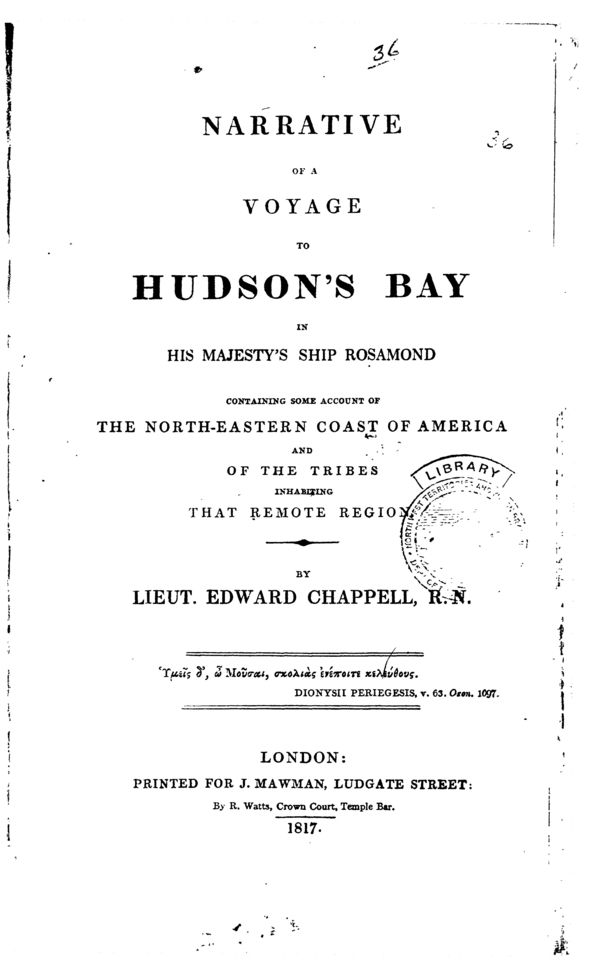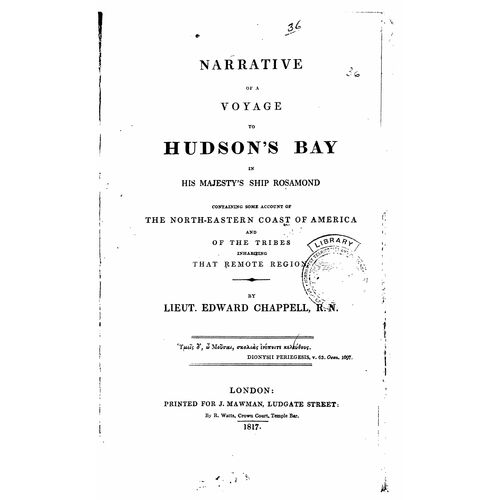
Source: Link
CHAPPELL, EDWARD, naval officer and author; b. 10 Aug. 1792 at Hothfield, Kent, England; m. 5 Oct. 1819 Elizabeth Wood (d. 1842), and they had one daughter; d. 21 Jan. 1861 in London, England.
In 1804 at age 12 Edward Chappell signed on board the Kingfisher at the Sheerness naval base near the village where he was born. During the Napoleonic wars he saw action in several ships from the Mediterranean to the West Indies. He helped in 1805 to cut out a Spanish privateer from under the heavy batteries of the La Guaira fortress on the Venezuelan coast. In 1811 Chappell was made a lieutenant, after commanding a gunboat at the siege of Cadiz, Spain, in which almost all the crew was killed or wounded and he himself severely injured.
He served in warships off Tunis and Toulon, and then joined the sloop of war Rosamond, which sailed to Newfoundland in 1813 and Hudson Bay in 1814 to patrol the British North American fisheries. During these voyages he recorded his observations in two journals, which were later published as Voyage of his majesty’s ship Rosamond to Newfoundland and the southern coast of Labrador and Narrative of a voyage to Hudson’s Bay. In the first of these journals Chappell described the summer cruise of 1813 in Newfoundland and Labrador waters, at a time when almost everyone lived along the coastline and by means of the fishery. After reaching St John’s at the end of May the Rosamond sailed around the south and west coasts of Newfoundland on her way to guard the fisheries on the Labrador coast, returning by the same route in autumn, and left St John’s for England in December. During this voyage Chappell noted the isolated settlements of whites, Indians, and Inuit (Eskimos) on the west coast of Newfoundland and the coast of Labrador; the crowded streets and lively social life of St John’s at the end of the fishing season; and extraordinary natural features, such as the unusual castle-like rock formations of Chateau Bay in the Strait of Belle Isle. Like other visitors, however, Chappell condemned the system of economic exploitation whereby the fish merchants were able to “amass the most splendid fortunes with an inconceivable rapidity; whilst the middling and lower classes of fishermen may toil from year to year, with patient and unremitted industry, and yet find themselves, in their old age, many degrees worse off than when they first crossed the Atlantic.”
In May 1814 the crew of the Rosamond learned that she had been ordered to Hudson Bay, and eight men, including the captain, left the ship in Suffolk, England. The ship convoyed two Hudson’s Bay Company ships and a Moravian mission brig across the Atlantic, and then proceeded to York Factory on Hudson Bay, returning by the same route in the fall. The rugged natural grandeur of the Arctic, with its mountains and icebergs, awed the young naval lieutenant. Chappell first met Arctic Inuit on 31 July, when he went ashore at Cape Saddleback in Hudson Strait. Although he refuted some earlier farfetched descriptions of Inuit, a number of his own conclusions were naive. Noting the natives’ small hands and feet, for example, he reasoned that “the same intense cold which restricts vegetation to the forms of creeping shrubs has also its effect upon the growth of mankind, preventing the extremities from attaining their due proportion.” He described more accurately the seal hunt and the importance of that animal to the natives’ way of life. Chappell did sketches of Inuit huts and kayaks, later included in his Narrative, and traded for sealskin clothes and white feather gloves. He knew a few common Inuit words but could not communicate with the natives in any depth. Chappell later defended his work against a critic in the Quarterly Review (London) by maintaining that he had daily contact with the natives and, unlike any European in the previous 40 years, had been admitted to their homes. But most of his observations on Inuit society and beliefs were superficial.
At York Factory, Chappell dined on venison steaks and buffalo tongue, to the tunes of Highland bagpipers, and joined some Crees to hunt reindeer. He described briefly in his journal the trading operations of the HBC, referring the reader, for the western portions of the company’s vast domains, to the journals of Alexander Mackenzie*. Chappell believed the Indians would become more industrious if the company’s monopoly were ended, and if they got a better deal for their furs.
On both his trips Chappell took part in every experience open to him with youthful buoyancy and resilience and talked to a wide range of people, from Moravian missionaries to Indian chiefs. In his books, which were essentially works of description and travel to be read by the British upper classes, he gives us glimpses of frontier societies which contained few educated people and about which little had been written. He displays, however, some understandable biases: Roman Catholic priests were jolly and rotund; Irishmen were turbulent drunkards; Indians and Inuit, although generally regarded as being good-natured and hospitable, were patronized in regard to their customs, religion, and drinking habits.
Chappell appears to have had no further connection with North America after the cruises of 1813 and 1814. Following the second voyage he presented some Inuit handicrafts to Cambridge University. After the Napoleonic wars, he served on warships patrolling the English Channel against smugglers. Promoted to commander in 1826, he supervised for the next 12 years the steam packet postal service around the British Isles. His superiors praised him as a hardworking officer whose conduct was pervaded by a “deep and moral sense of justice and truth.” In 1838 Chappell was made a captain and two years later circumnavigated Britain in the steamer Archimedes in order to assess the newly developed screw propeller. He became an authority on steam navigation, giving evidence to committees of the British House of Commons, and advising the Board of Trade on legislation. In 1841 he went on half pay in order to manage the Royal Mail Steam Packet Company, which ran vessels to the West Indies. He retired from the navy in 1853 and was promoted rear-admiral in 1858, three years before his death.
Edward Chappell was the author of Narrative of a voyage to Hudson’s Bay in his majesty’s ship Rosamond containing some account of the northeastern coast of America and of the tribes inhabiting that remote region (London, 1817); Voyage of his majesty’s ship Rosamond to Newfoundland and the southern coast of Labrador . . . (London, 1818), which also appeared as Reise nach Neufoundland und der sudlichen Kuste von Labrador . . . nebst einer Beschreibung der Insel Cuba, und besonders der Stadt Havanna im Jahre 1817 . . . (Jena, 1819); and Reports relative to Smith’s patent screw propeller . . . (London, 1840). PRO, Adm. 9/24, 36/17116, 37/919. Somerset House (London), Principal Probate Registry, Letters of administration, Edward Chappell, 6 Feb. 1861. G.B., Adm., The commissioned sea officers of the Royal Navy, 1660–1815, ed. D. B. Smith et al. (3v., n.p., [1954?]), I, 160; Navy list, 1811–61. O’Byrne, Naval biographical dictionary (1849), 186–87. Quarterly Rev. (London), XVIII (1817–18), 199–223.
Cite This Article
William H. Whiteley, “CHAPPELL, EDWARD,” in Dictionary of Canadian Biography, vol. 9, University of Toronto/Université Laval, 2003–, accessed January 10, 2026, https://www.biographi.ca/en/bio/chappell_edward_9E.html.
The citation above shows the format for footnotes and endnotes according to the Chicago manual of style (16th edition). Information to be used in other citation formats:
| Permalink: | https://www.biographi.ca/en/bio/chappell_edward_9E.html |
| Author of Article: | William H. Whiteley |
| Title of Article: | CHAPPELL, EDWARD |
| Publication Name: | Dictionary of Canadian Biography, vol. 9 |
| Publisher: | University of Toronto/Université Laval |
| Year of publication: | 1976 |
| Year of revision: | 1976 |
| Access Date: | January 10, 2026 |



